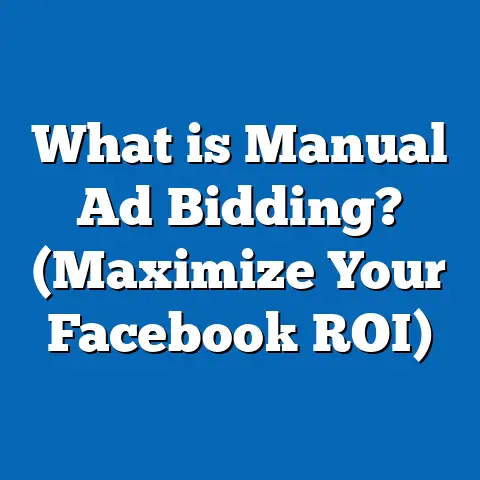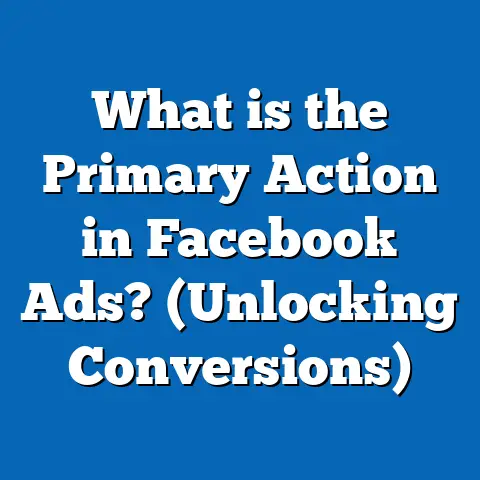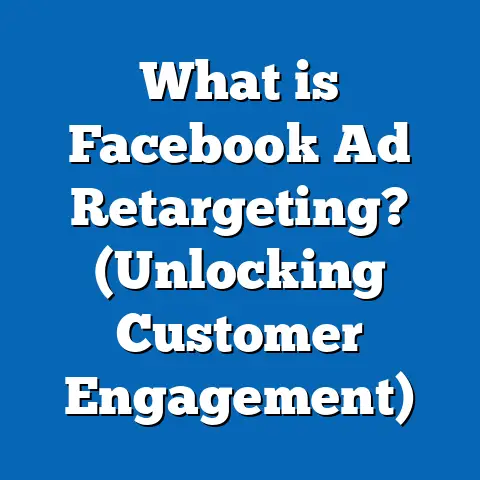What is Flexible Media in Facebook Ads? (Maximize Engagement)
Introduction: The Pulse of Innovation in Facebook Advertising
In the fast-moving world of digital marketing, innovation is the heartbeat of success. Facebook—now part of Meta—has continually raised the bar, giving advertisers cutting-edge tools to reach and engage their ideal audiences. Among these, Flexible Media stands out as a transformative approach. It empowers marketers to adapt creative assets for maximum impact, regardless of device, placement, or audience behavior. In an era where attention is fleeting and competition is fierce, understanding Flexible Media isn’t just an advantage—it’s essential.
What Is Flexible Media in Facebook Ads?
The Evolution of Ad Creative on Facebook
Advertising on Facebook has evolved from static images and basic text to immersive, dynamic experiences. Early Facebook ads were limited to specific dimensions and formats, often leading to suboptimal display across devices. As user behavior shifted—more mobile browsing, shorter attention spans—advertisers needed adaptable solutions. Flexible Media emerged as a response, offering versatility and relevance at scale.
Defining Flexible Media
Flexible Media refers to creative assets designed to automatically adjust their size, layout, orientation, and even content based on the platform’s requirements and user context. Instead of building separate assets for every ad placement (like Feed, Stories, Reels, or Marketplace), advertisers can upload a single set of flexible assets. Facebook’s algorithms then optimize how these appear—ensuring high-quality delivery without manual intervention.
Key Features:
- Automatic Resizing: Adjusts images and videos to fit various placements.
- Dynamic Cropping: Focuses on main subjects for different aspect ratios.
- Content Adaptation: Allows for text overlays or CTAs to shift placement or style.
- Responsive Design: Ensures visuals look sharp on any device.
Why Flexible Media Matters: Data-Driven Insights
The Need for Adaptability
- 98.5% of Facebook users access the platform via mobile devices (DataReportal, 2024).
- Facebook supports over 15 unique ad placements across its ecosystem.
- Ads designed for multi-placement deliver up to 32% higher ROI than single-placement creatives (Meta Internal Data, 2023).
Impact on Engagement and Performance
- Campaigns using Flexible Media see an average 28% increase in engagement rates compared to static, non-adaptive creatives (Meta for Business, 2023).
- Adaptive creative increases video completion rates by up to 40% in Stories and Reels placements.
- Brands using Flexible Media reported a 21% decrease in cost-per-action (CPA) due to improved relevance scores.
Core Components of Flexible Media
Multi-Aspect Ratio Support
Facebook recommends using multiple aspect ratios—such as 1:1 (square), 4:5 (vertical), and 16:9 (landscape)—to maximize visibility across placements. Flexible Media enables automatic or semi-automatic adaptation to these formats.
Example:
- A single video asset can be uploaded in 16:9, and Facebook’s tools will generate appropriate crops for Stories (9:16) or Feeds (4:5), minimizing manual editing.
Dynamic Creative Optimization (DCO)
Flexible Media pairs seamlessly with Dynamic Creative Optimization. DCO automatically tests combinations of headlines, images, videos, and calls-to-action (CTAs) to serve the most effective variant to each user.
Example:
- A retailer uploads 5 images, 3 headlines, and 2 descriptions. DCO can generate 30 unique ad variants, each optimized by Facebook’s algorithm for engagement.
Asset Customization Per Placement
Some placements allow asset customization—uploading different versions of an image or video for Feed vs. Stories vs. Audience Network. Flexible Media simplifies this process by suggesting optimal crops and layouts.
Practical Implementation: How to Use Flexible Media
Getting Started in Ads Manager
- Set Up Your Campaign Objective: Awareness, Traffic, Conversions, etc.
- Choose Placements: Select Automatic Placements for best results.
- Upload Creative Assets: Add multiple aspect ratios or leverage Facebook’s cropping tools.
- Enable Dynamic Creative (Optional): For automated testing and optimization.
- Review Previews: Check how ads appear across placements before publishing.
Best Practices
- Always include vertical formats for Stories and Reels.
- Use high-resolution assets to prevent pixelation during resizing.
- Test short-form videos (under 15 seconds) for optimal performance in mobile-first placements.
- Keep text overlays concise—20% rule still applies for readability.
Real-World Case Studies: Results That Matter
Case Study 1: Fashion Retailer Boosts Video Engagement
A global fashion brand used Flexible Media with a mix of product videos and lifestyle images. By allowing Facebook to auto-crop videos for Stories and Feeds:
- Engagement rates rose by 31% within two weeks.
- Video completion rate improved from 23% to 38%.
- Cost per click dropped by 19% compared to single-format creative.
Case Study 2: Local Restaurant Chain Drives In-store Visits
A restaurant group tested static images versus flexible video assets for a new menu launch:
- Flexible Media campaign saw a 22% lift in store footfall.
- Dynamic creatives tailored CTA placement for each device—mobile users got “Order Now,” desktop users saw “Book a Table.”
- The campaign outperformed traditional ads by reducing CPA by 27%.
Case Study 3: SaaS Company Increases Lead Quality
A B2B SaaS provider targeted multiple audience segments with personalized flexible ads:
- Lead quality score increased by 16 points (internal metric).
- Cost per qualified lead decreased by 26% due to higher ad relevance.
- A/B testing showed flexible creatives delivered twice as many conversions as static ads.
Technical Deep Dive: How Flexible Media Works
Facebook’s Ad Delivery Algorithms
Facebook uses machine learning to decide which version of your creative gets shown where and when. The algorithm considers:
- Placement type (Feed, Stories, In-stream)
- Device orientation (portrait vs. landscape)
- User engagement patterns
- Historical performance data
By feeding the algorithm flexible assets, you let it optimize for engagement at a granular level that would be impossible manually.
File Specifications & Recommendations
| Placement | Aspect Ratio | Recommended Format | Max File Size |
|---|---|---|---|
| Feed | 1:1 or 4:5 | JPG/PNG/MP4 | 30 MB |
| Stories/Reels | 9:16 | MP4/MOV | 4 GB |
| In-stream Video | 16:9 | MP4/MOV | 4 GB |
Pro Tip: Always upload the highest quality available within file size limits to preserve clarity post-compression.
Comparison with Other Platforms
Instagram vs. Facebook Flexible Media
While both platforms support multi-aspect ratio ads, Facebook’s backend offers more robust DCO tools and placement customization options.
| Feature | ||
|---|---|---|
| Multi-placement support | Extensive | Moderate |
| Dynamic creative | Advanced | Basic |
| Asset customization | Per placement | Limited |
| Audience targeting | Granular | Broad |
Google Display Network (GDN) vs. Facebook Flexible Media
Google Display’s Responsive Ads offer similar adaptive features but differ in execution:
- GDN relies heavily on text + visual combinations; Facebook leans into video and richer media.
- Facebook’s optimization is driven by deep behavioral data; GDN focuses on contextual signals.
Advanced Strategies for Maximizing Engagement
Leverage User Behavior Data
Flexible Media unlocks granular insights into what creative works best for which audience segment. Use breakdown reporting in Ads Manager to analyze:
- Which aspect ratio drives highest engagement per placement
- Conversion rates by device type
- Variations in CTA performance
Personalization at Scale
Combine Flexible Media with audience segmentation—customize visuals or messaging for retargeting vs. prospecting audiences. For example:
- Prospects see educational videos; existing customers get loyalty offers.
- Regional language overlays based on user location.
Creative Refresh Cycles
With automated adaptation in place, you can refresh creatives more frequently without overhauling your entire asset library. Set reminders to update visuals every 4–6 weeks based on performance data.
Common Pitfalls & How to Avoid Them
Over-reliance on Automation
Automation is powerful but not infallible. Review previews in Ads Manager and manually adjust crops when necessary—especially for text-heavy images or logo placements.
Ignoring Placement-Specific Contexts
An ad that works well in Feed may not suit Stories or Reels due to differing user expectations and attention spans. Tailor your narrative accordingly.
Asset Quality Issues
Low-resolution uploads may look fine on desktop but appear blurry on mobile or high-DPI screens after resizing. Invest in professional-quality visuals from the start.
The Future of Flexible Media: Trends & Predictions
AI-Powered Creative Generation
Meta is investing in generative AI tools that will soon allow advertisers to create flexible assets directly within Ads Manager—auto-generating alternative layouts, colors, or even copy variations based on campaign goals.
Shoppable & Interactive Formats
Expect more interactive ad types—like AR try-ons or instant shopping experiences—that leverage flexible design principles for seamless cross-device engagement.
Privacy & Signal Loss Adaptation
As third-party cookies fade and privacy regulations tighten, flexible creative will become even more important for delivering relevance without granular targeting data.
Practical Checklist: Implementing Flexible Media Today
- Audit your current creative assets—do they cover all recommended aspect ratios?
- Enable automatic placements and dynamic creative in new campaigns.
- Use Facebook’s Creative Hub for mockups and testing.
- Monitor performance breakdowns weekly; adjust asset mix as needed.
- Refresh creative regularly based on insights—not just on schedule.
Key Takeaways & Next Steps
- Flexible Media is essential for maximizing engagement and ROI across today’s fragmented digital landscape.
- It enables your ads to look their best everywhere—without added manual workload.
- Combining flexible assets with dynamic optimization leads to measurable lifts in performance metrics.
- Stay current with Meta’s evolving tools and industry trends to keep your campaigns ahead of the curve.
Actionable Next Steps:
- Start testing Flexible Media with your next Facebook campaign.
- Analyze results using placement breakdowns—double down on what works best.
- Invest in high-quality asset creation upfront—it pays off through improved performance at scale.
Ready to unlock higher engagement and better results? Make Flexible Media the foundation of your Facebook advertising strategy today.






